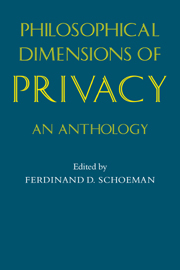Book contents
- Frontmatter
- Contents
- List of contributors
- Preface
- 1 Privacy: philosophical dimensions of the literature
- 2 Social distance and the veil
- 3 The origins of modern claims to privacy
- 4 The right to privacy [the implicit made explicit]
- 5 Privacy [a legal analysis]
- 6 Privacy as an aspect of human dignity: an answer to Dean Prosser
- 7 Privacy [a moral analysis]
- 8 Privacy, freedom, and respect for persons
- 9 Privacy and self-incrimination
- 10 Intimacy and privacy
- 11 The right to privacy
- 12 Why privacy is important
- 13 Privacy, intimacy, and personhood
- 14 Privacy: some arguments and assumptions
- 15 An economic theory of privacy
- 16 Privacy and the limits of law
- 17 Privacy and intimate information
- Selected bibliography
- Index of names
13 - Privacy, intimacy, and personhood
Published online by Cambridge University Press: 12 December 2009
- Frontmatter
- Contents
- List of contributors
- Preface
- 1 Privacy: philosophical dimensions of the literature
- 2 Social distance and the veil
- 3 The origins of modern claims to privacy
- 4 The right to privacy [the implicit made explicit]
- 5 Privacy [a legal analysis]
- 6 Privacy as an aspect of human dignity: an answer to Dean Prosser
- 7 Privacy [a moral analysis]
- 8 Privacy, freedom, and respect for persons
- 9 Privacy and self-incrimination
- 10 Intimacy and privacy
- 11 The right to privacy
- 12 Why privacy is important
- 13 Privacy, intimacy, and personhood
- 14 Privacy: some arguments and assumptions
- 15 An economic theory of privacy
- 16 Privacy and the limits of law
- 17 Privacy and intimate information
- Selected bibliography
- Index of names
Summary
The Summer 1975 issue of Philosophy & Public Affairs featured three articles on privacy, one by Judith Jarvis Thomson, one by Thomas Scanlon in response to Thomson, and one by James Rachels in response to them both. Thomson starts from the observation that “the most striking thing about the right to privacy is that nobody seems to have any very clear idea what it is” (p. 295) and goes on to argue that nobody should have one—a very clear idea, that is. Her argument is essentially that all the various protections to which we feel the right to privacy entitles us are already included under other rights, such as “the cluster of rights which the right over the person consists in and also … the cluster of rights which owning property consists in” (p. 306). After a romp through some exquisitely fanciful examples, she poses and answers some questions about some of the kinds of “invasions” we would likely think of as violations of the right to privacy:
Someone looks at your pornographic picture in your wall-safe? He violates your right that your belongings not be looked at, and you have that right because you have ownership rights—and it is because you have them that what he does is wrong. Someone uses an X-ray device to look at you through the walls of your house? […]
- Type
- Chapter
- Information
- Philosophical Dimensions of PrivacyAn Anthology, pp. 300 - 316Publisher: Cambridge University PressPrint publication year: 1984
- 24
- Cited by



